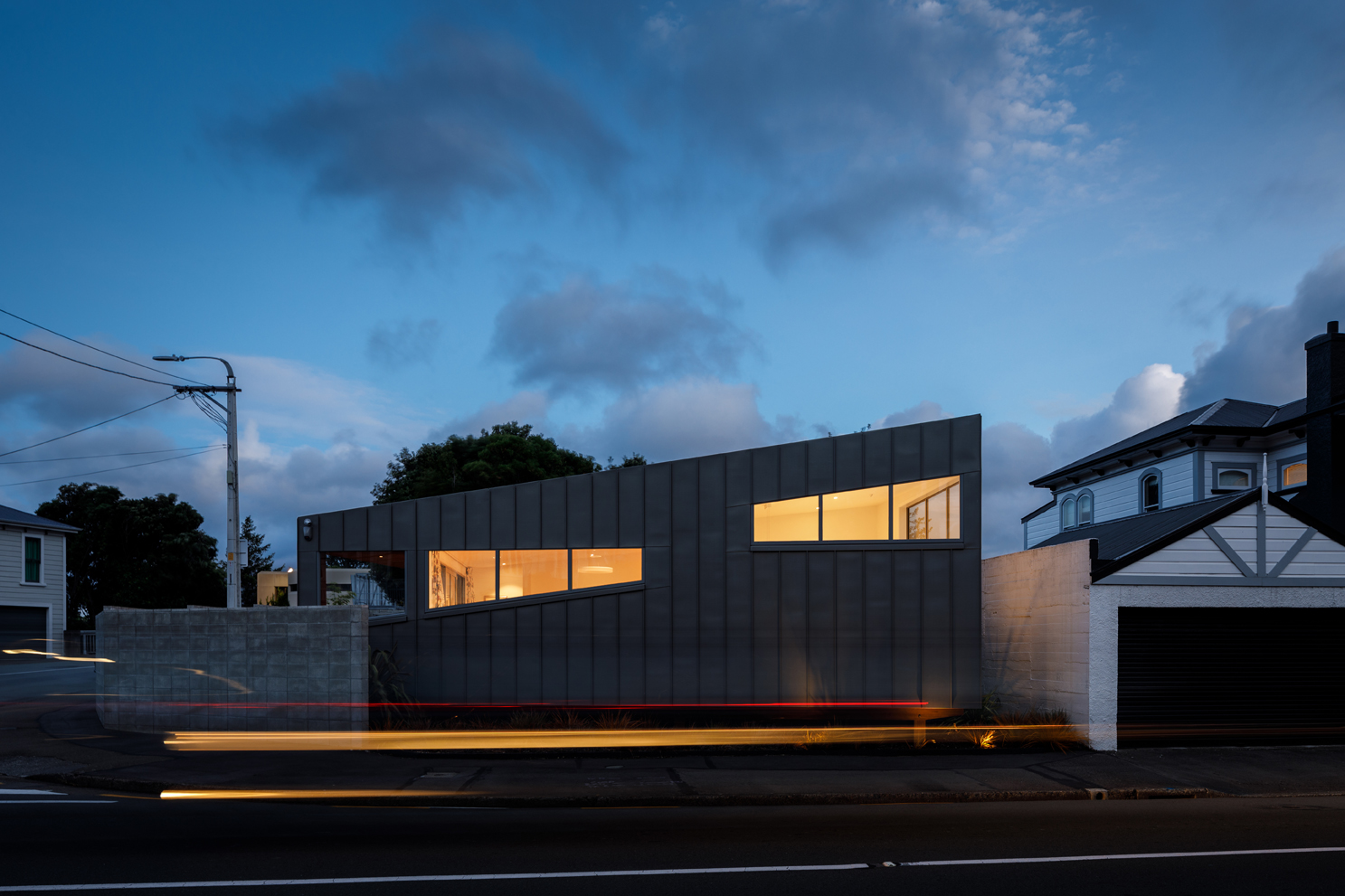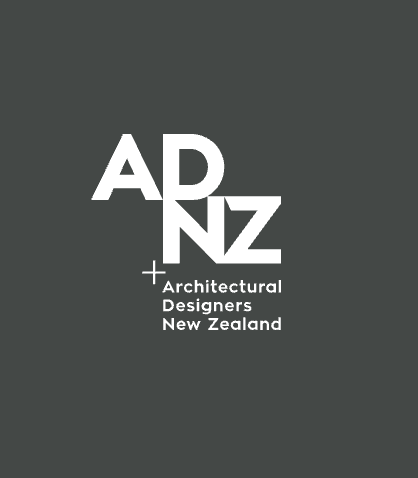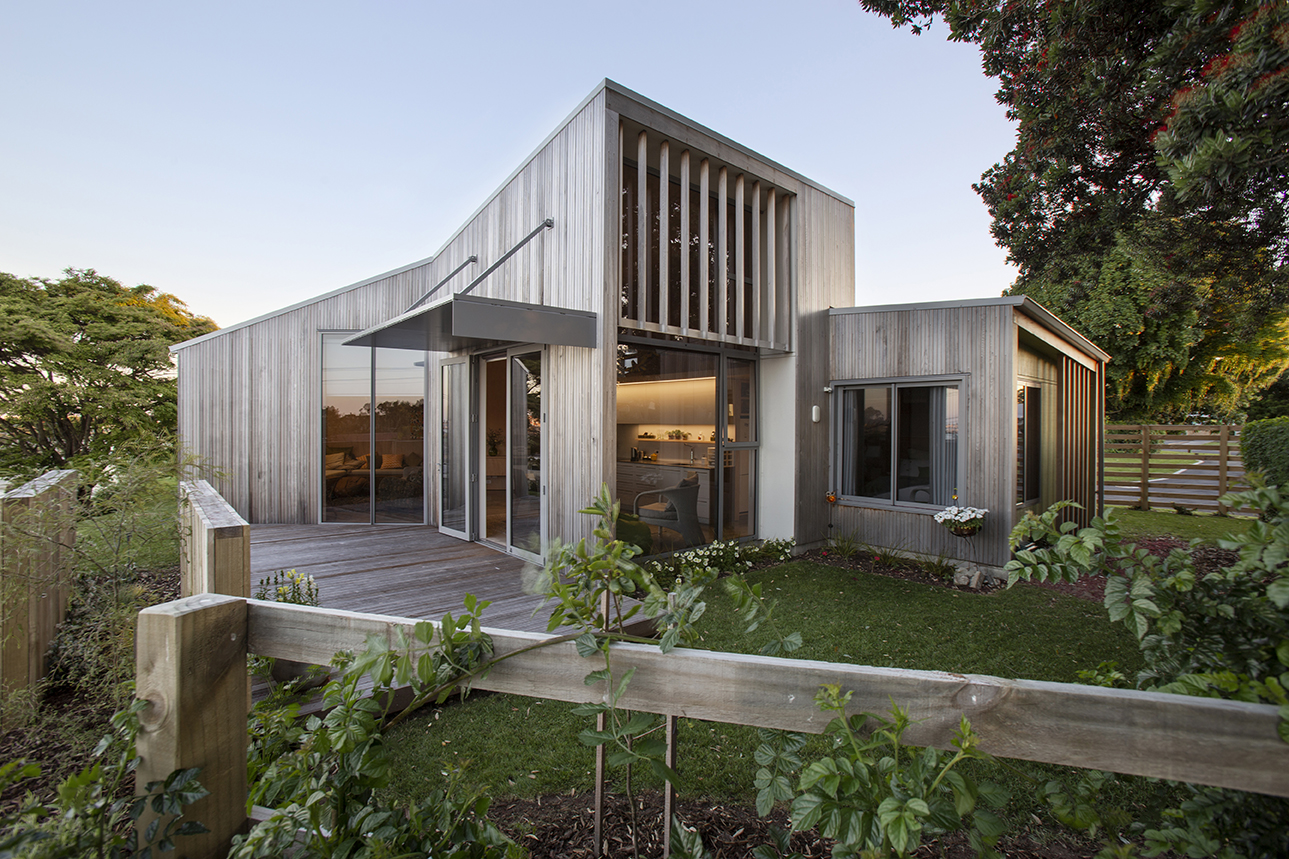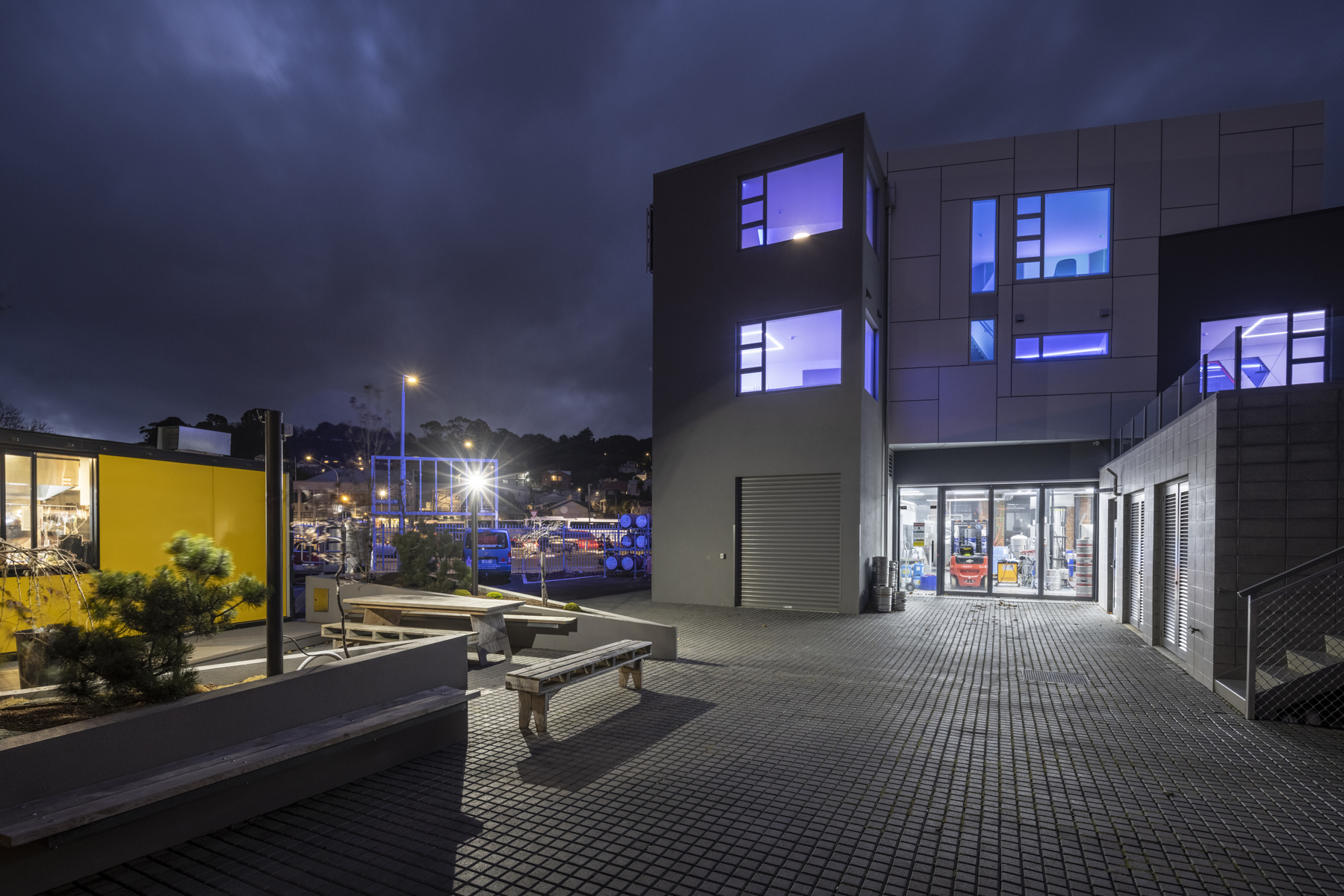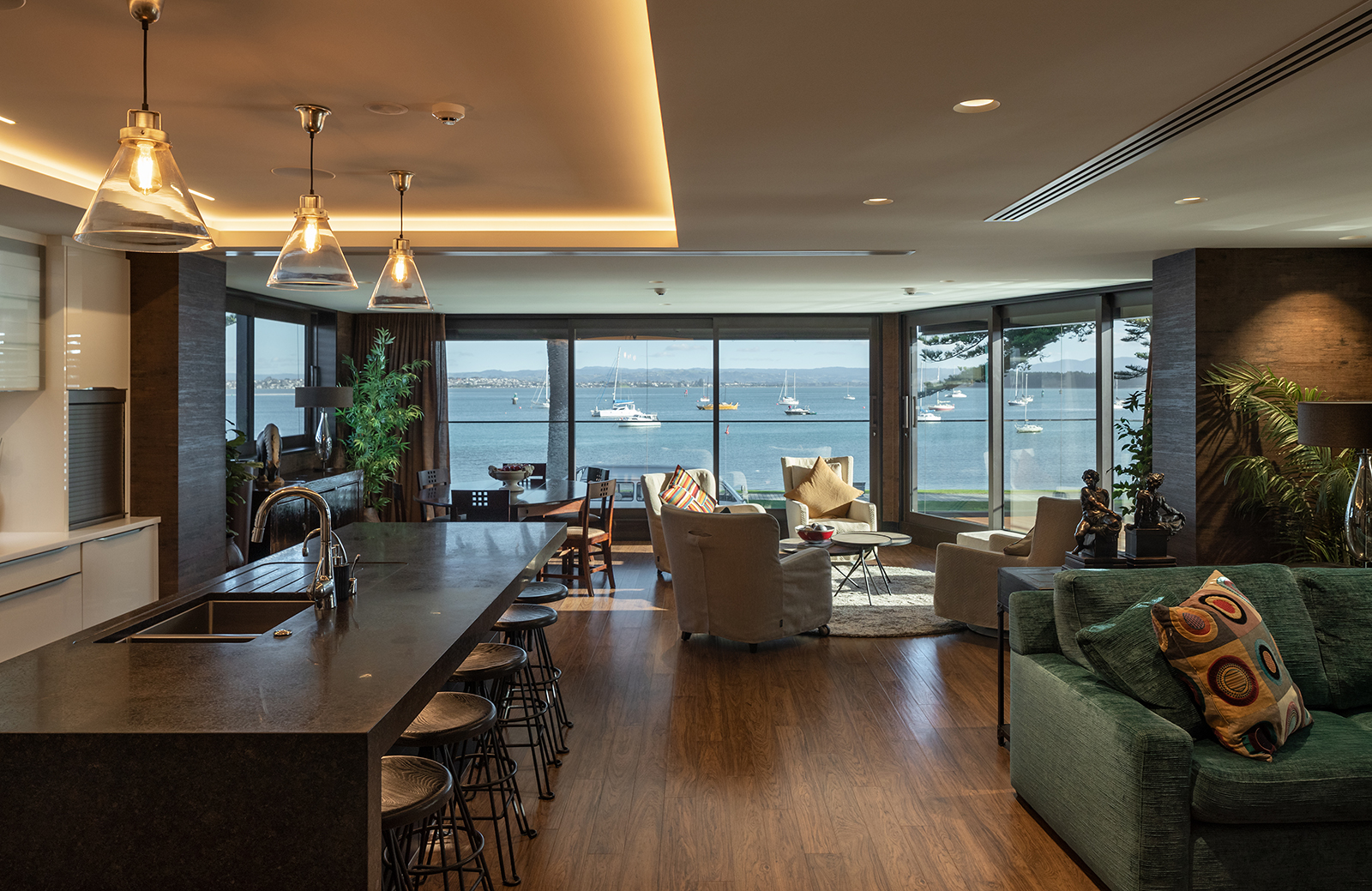A ferocious wind is lashing the Capital City, and the motorway is in full rush- hour roar below. How could anyone in their right mind build on this noisy, odd angled, corner section, next to the overbridge?
Further down the street, imposing embassies line the way, while above stately Edwardian and Victorian mansions loom, grand, white and wooden beneath dark brooding hills. Wellington’s seismically notorious fault line provides yet another challenge to the person who dares to create something new here. Yet sure enough, lying low, dark and incongruous, an armadillo-like zinc skinned, boldly angled building has appeared.
Wedged within its odd shaped space it rears prow-like towards the upper pavement. It is as if this unique contemporary creature has crept out from the trees and quietly planted itself there. This latest addition to the neighbourhood is solid as a rock. A modern-day piece of history which references the industrial reality of the motorway and the overbridge next door. It speaks of a certain defiance to the harsh elements, and to all that surrounds it, in this established area.
The property was designed by James Mackie, of Mackit Architecture, for clients Chris O’Brian and Katrina Oliver, who bought the land from NZTA seven years ago. Originally two sites, the New Zealand Transport Authority acquired the area to transform the original suspension walk bridge joining Hobson Street with Tinakori Road into a vehicle overbridge. The sections were further reduced to enable a wider easement onto Tinakori Road.
Chris and Katrina, who were living nearby at the time, saw a “for sale” notice in the paper. Eventually, when no-one had offered to take up such a difficult site, they made a successful offer.
Originally planning to build two homes, always contemporary and boxed in design, they eventually decided on one, and after extensive investigation approached James. After considering the site’s challenges, James convinced the owners to angle the build right to the section’s edges, bringing light in at higher points through interestingly angled windows. Title conditions included exceptional levels of building acoustics and that no complaints be made to NZTA about motorway noise.
Expertise was sought from acoustic engineer Malcolm Hunt and structural engineer Jared Sullivan, who worked on the home’s foundation/bracing and seismic requirements. Matthew Palmer was responsible for construction. Zinc, with a bracing skin of ply underneath, was chosen for its durability, industrial aesthetic and seismic and sound protection. While expensive, the owners believe it will prove a long-term winner. “I wanted to make something that will be there in 150 years, which people will maintain and treasure, rather than another contemporary disposable. I want this building to be part of the Tinakori landscape,” says James.
The house stands solid and fortress- like, yet floats and touches lightly on the landscape. A bespoke suspended foundation involving large laminated timber piles and bearers, designed to withstand a 1 in 2,500-year seismic event, allows crawl space underneath for future maintenance or repairs. Almost hidden from view with its grey zinc exterior and cedar and stainless steel detailing, the house is wrapped at the corner by a concrete block wall which only the tallest of pedestrians can peep over.
Leaving the wind and roar of traffic behind, entering the house offers a tangible transition towards instant inner peace. Warmly greeted by Chris and Katrina as the door shuts softly but firmly, the interior feels like a sanctuary. Almost hermetically sealed from the inside, with exterior opening doors only in the living room, entrance and garage, everything possible has been done to achieve a quiet inner living space. The house is fully reliant on mechanical ventilation and heat exchange systems. Thermal insulation provides an even temperature throughout while also completely separating the interior from outside noise.
From inside, the house is light and bright. Dramatically angled kitchen and living room windows highlight magnificent views of those historic stately homes, the Tinakori hills and sunsets beyond. Switchable opaque windows offer privacy while doing away with the need for difficult shaped blinds.
Despite the odd comment from neighbours about bunkers, the overall interest in this new addition to the streetscape has been genuine and positive. Katherine Mansfield’s home is just along the way ... and I can’t help wondering just what she would have written about this bold new neighbour. Surrounded by greatness, this home is also great in a very different way. It too is making a statement and has been built to last. A modern-day icon, it pays homage to the industrial engineering of the overbridge and the motorway and surprises with a light and peaceful interior.
Greytown, the oldest town in the Wairarapa was the obvious fit for Mackit Architects. Surrounded by homes which have lasted 150 years or more, it is no surprise that architectural designer James Mackie is passionate about legacy.
“In a world that wants everything immediately, there’s a craftsmanship and quality
I like to pursue, that pays off over a lifetime.” His specialty is creating bespoke modern residential architecture. “Clients tend to come to me because they like my style. I like angular shapes and simple clean details.” Having acquired a Bachelor of Design with honours 2002 - 2005 and qualified in carpentry 2004-2006, he became a registered master builder and a licensed building practitioner in both design and carpentry.
James says he wears two hats. First, he will conceptualise without restraint and when the vision is fully formed, he will then apply his building knowledge and skill to make it happen. He loves the challenge of working with a tricky site. “I don’t want to shout with what we do. I’d much rather have a dark building which tucks into the background.” He likes his buildings to be sophisticated in design and to wrap around existing landforms, trees or bush.
James believes high quality bespoke buildings are becoming more and more expensive.
It’s like buying a Ferrari, when we need to find ways to make quality builds more accessible. “We need homes which don’t just meet the building codes but exceed them.”
Photography by Andre Vroon
